Surf watch
Figuring out the waves and the wind is an important part of surfing.
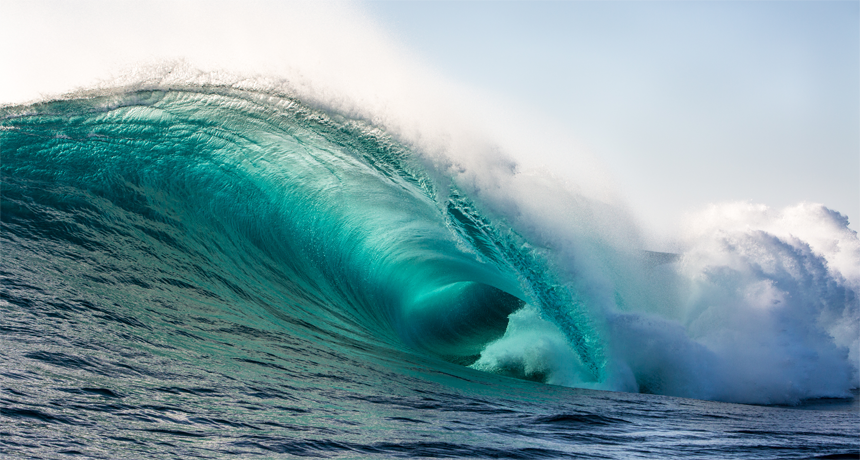
halfbinz/istockphoto
By Emily Sohn
I usually hate getting up early. But during a recent surfing trip to Mexico, I was up with the sun. I couldn’t wait to get to the beach.
Even so, I didn’t plunge into the water right away. I watched the waves and studied surfers in action. I tried to figure out how big the swells were, which way the wind was blowing, and where the waves were breaking.
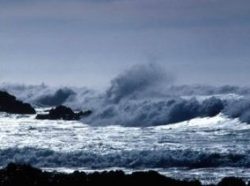 |
|
Winds can stir up large waves, which break when they approach shore.
|
| National Oceanic and Atmospheric Administration |
I soon learned that every day was different. Conditions changed constantly. Tides came and went. Winds shifted. No two waves were alike. How, I wondered, do surfers know what to expect?
“It’s 100-percent science,” says Vic DeJesus, a meteorologist and surf forecaster for WaveWatch. Wave predictions have become so reliable, he says, that many surfers check Web sites such as WaveWatch several times a day. And, as scientists continue to analyze the movement of water around the globe, predictions keep improving.
The research is helping make life safer and more fun for surfers, to be sure, but they aren’t the only ones who care about wave forecasts. Accurate information is also useful for lifeguards, boaters, biologists, engineers, and other people who need to know what the ocean is doing.
Predicting waves
Predicting waves, for the most part, depends on reading winds. To see why, fill a tub with water. Wait until the liquid becomes still. Then, blow across its surface and watch the ripples.
Like your breath, winds create ripples in the ocean. With enough wind, ripples form waves that crash when they hit the shore or a shallow reef. Near the shore, the ground causes the bottom of the wave to slow down, which makes the top curl over and break.
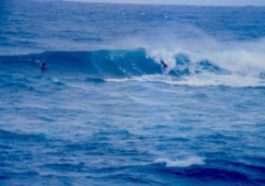 |
|
Surfing on the North Shore, Oahu, Hawaii.
|
| Commander John Bortniak, NOAA Corps |
The stronger the wind, the bigger the waves, says Jerome Aucan, a surfer and oceanographer at the University of Hawaii in Honolulu.
“There are three main factors in surf forecasting: wind speed, area over which the wind blows, and how long it blows,” says Aucan.
Winds are most powerful when storms are brewing, Aucan says, and waves can travel a long way. Swells that hit the west coast of Mexico often start as squalls as far away as New Zealand, thousands of miles away. The best waves in France often begin as major storms called nor’easters, which sweep across the coasts of New York and New England.
Better forecasting
Wave forecasting began during World War II, when the U.S. military was planning attacks from the sea and needed to know the size of the surf, Aucan says. Oceanographers started by creating wind maps and observing the connection between wind patterns and swell size.
Now, more than 50 years later, computer programs do most of the work. These models rely on data that come from ocean buoys and space satellites, both operated by the National Oceanic and Atmospheric Administration (NOAA).
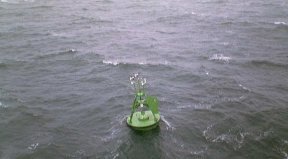 |
|
A buoy measures wave height and wind speed, transmitting the information to satellites.
|
| National Weather Service Forecast Office, Portland, Maine |
Floating buoys measure the height of wave surges, the distance between waves, and wind speed. Satellites use altimeters and other tools to calculate wave height from above. Ocean depth and topography (the shape of the ground underwater) also affect waves.
Scientists plug in as much data as possible into the models, which spit out charts that show where the waves are going and how they will probably change as they move. Professional wave forecasters such as DeJesus use these charts in combination with other methods.
“I get up between 4:30 and 5:00 a.m.,” DeJesus says. “I call friends, people I hire. They tell me if it’s windy, good, bad, ugly, whatever. The rest of the day, I go through weather charts, wave models, and I prepare forecasts for the next 48 to 96 hours and up to a week later.”
Oceanographers are still tweaking the models, but the short-term formulas already work pretty well. “Within 24 to 36 hours, you can usually hit anywhere between 90- and 100-percent accuracy,” DeJesus says. After that, the accuracy of forecasts drops rapidly.
Weather conditions
Better long-term forecasts will depend on better predictions of the wind’s behavior and closer attention to geographical details, Aucan says. Scientists are working on these questions. Ultimately, though, forecasting will never be perfect, because weather conditions can always change without warning.
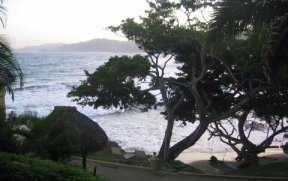 |
|
The beach and waves off the west coast of Mexico.
|
| E. Sohn |
Still, surfers would rather rip it up on smooth, clean waves than fight 50 mile-per-hour winds. To that end, wave forecasts help determine whether or not it’s worth waxing up the board. In the meantime, surfers often become experts of the ocean.
“I think surfers end up being kind of like scientists,” says Julie Cox, a 26-year-old competitive surfer and surf instructor from Santa Cruz, Calif. “Surfing involves wave prediction, meteorology, astronomy, the sun, the moon, tides, seasons, geography, and topography. You learn about the chemistry of the water, temperature, salinity, and animals, like stingrays, seals, otters, and whales.”
Surfing is more than a sport. It’s a scientific education. After a week of “fieldwork” in Mexico, I realized how much more I have to learn. And because catching waves is such a rush, it’s a class I’ll get up early for any day.
Going Deeper:







